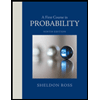
A First Course in Probability (10th Edition)
10th Edition
ISBN: 9780134753119
Author: Sheldon Ross
Publisher: PEARSON
expand_more
expand_more
format_list_bulleted
Question

Transcribed Image Text:Let X₁, X2,..., be a sequence of independent and identically distributed random variables, each
with a mean value x and variance ok, both of which are assumed to be finite. Let N be a discrete
random variable independent of X₁, X2,..., and assuming values in the set {0, 1, 2, ...}, with mean
value N and variance ok (both are finite). Form the random-compound sum Y=1 Xk, with
the convention Y = 0 whenever N = 0.

Transcribed Image Text:Find the expressions for the mean and variance of Y in terms of ux, o, μN and o.
SAVE
AI-Generated Solution
info
AI-generated content may present inaccurate or offensive content that does not represent bartleby’s views.
Unlock instant AI solutions
Tap the button
to generate a solution
to generate a solution
Click the button to generate
a solution
a solution
Knowledge Booster
Similar questions
- A certain mutual fund invests in both U.S. and foreign markets. Let x be a random variable that represents the monthly percentage return for the fund. Assume x has mean ? = 1.8% and standard deviation ? = 0.6%. A) The fund has over 325 stocks that combine together to give the overall monthly percentage return x. We can consider the monthly return of the stocks in the fund to be a sample from the population of monthly returns of all world stocks. Then we see that the overall monthly return x for the fund is itself an average return computed using all 325 stocks in the fund. Why would this indicate that x has an approximately normal distribution? Explain. B) After 6 months, what is the probability that the average monthly percentage return x will be between 1% and 2%? Hint: See Theorem 7.1, and assume that x has a normal distribution as based on part (a). (Round your answer to four decimal places. C) After 2 years, what is the probability that x will be between 1% and 2%? (Round your…arrow_forwardSuppose that the time students wait for a bus can be described by a uniform random variable X, where X is between 15 minutes and 55 minutes. (a) What is the probability, P that a student will wait between 15 and 25 minutes for the next bus?P = (b) What is the probability, P that a student will have to wait at least 25 minutes for the next bus?arrow_forwardOrders come into a pizza place by phone are either for cheese or pepperoni pizza. The time to process and cook a cheese pizza is an exponential random variable with expected value 3 minutes, while the time to process and cook a pepperoni pizza is an exponential random variable with expected value 10 minutes. An order is for a cheese with probability 0.8, or for pepperoni with probability 0.2. The status of orders and processing times are independent across all orders. Define X as the processing time of the next order. (a) Find P[X > 4] (b) Find E[X] (c) Find Var(X)arrow_forward
- Consider a financial asset (for instance a stock) and assume its value today is $100. Let X; be the change in value of the asset (in $) on day i. After 60 days, the value of the asset will be X = 100+ X₁+X2+...+X60- We model these unknown price changes, X,, as random variables with the properties: The random variables X, are independent. ⚫ The random variables X, have expected value $0.3 and standard deviation $1.2. (a) Estimate the probability that we make a gain in our investment, i.e. P(X >$100). You may use the table in the appendix.arrow_forwardAn ordinary (fair) coin is tossed 3 times. Outcomes are thus triples of "heads" (h) and "tails" (1) which we write hth, ttt, etc. For each outcome, let N be the random variable counting the number of heads in each outcome. For example, if the outcome is htt, then N (htt) = 1. Suppose that the random variable X is defined in terms of N as follows: X=2N-N2 -4, The values of X are given in the table below. Outcome hht tth hth thh tht ttt hhh htt Value of x -4 -3 -4 -4 -3 -4 -7 -3 Calculate the probabilities P(X=*) of the probability distribution of X. First, fill in the first row with the values of X. Then fill in the appropriate probabilities in the second row. Value of x _ _ _ p(X=x) _ _ _arrow_forwardSuppose that40%of the applicants for a certain job possess advanced training in computerprogramming. Applicants are interviewed sequntially and are selected at random from the pool. Find theprobability that the 4th applicant with advanced training in programming is found on the 8th interview.To answer this question, first identify the random variable, its distribution and the parameter(s) of the distribution.arrow_forward
- Assume that the number of new visitors to a website in one hour is distributed as a Poisson random variable. What is the probability that in any given hour zero new visitors will arrive at the website?arrow_forwardAn ordinary (fair) coin is tossed 3 times. Outcomes are thus triples of "heads" (h) and "tails" (t) which we write hth, ttt, etc. For each outcome, let N be the random variable counting the number of heads in each outcome. For example, if the outcome is hhh, then N (hhh) = = 3. Suppose that the random variable X is defined in terms of N as follows: X=6N-2N²-3. The values of X are given in the table below. Outcome hhh hth hht thh htt tth ttt tht Value of X-3 1 1 1 1 1 -3 1 Calculate the probabilities P (X=x) of the probability distribution of X. First, fill in the first row with the values of X. Then fill in the appropriate probabilities in the second row. Value X of X P(X=x) 0 0 0 00 Xarrow_forwardIf n independent random variables have the samegamma distribution with the parameters α and β, find themoment-generating function of their sum and, if possible,identify its distribution.arrow_forward
- A shipment contains 20 assembled circuit boards of which five are defective. Tencircuit boards from the shipment are selected without replacement. Suppose that Xdenotes the number of defective boards out of the 10 selected. Find the probabilitydistribution of the random variable X and then find its mean and variancearrow_forwardSuppose that Wall A is constructed by stacking 30 metal blocks, and that the height of each metal block is an independent N(50, 10) normal random variable. Suppose that Wall B is constructed by stacking 25 wood blocks, and that the height of each wood block is an independent N(61, 4) normal random variable. What are the distributions of the heights of Wall A and Wall B? (b) What is the probability that Wall A is taller than Wall B?arrow_forwardThe random variable x represents the number of phone calls an author receives in a day, and it has a Poisson distribution with a mean of 8.6 calls. What are the possible values of x? Is a value of x = 2.9 possible? Is x a discrete random variable or a continuous random variable? What are the possible values of x? О А. 1, 2, 3, .. В. О, 1, 2, 3, ... C. any real number greater than or equal to 0 D. any real number greater than or equal to 0 and less than or equal to 8.6 Is a value of x= 2.9 possible? Is x a discrete random variable or a continuous random variable? A value of x = 2.9 possible because x is a random variable. is not isarrow_forward
arrow_back_ios
SEE MORE QUESTIONS
arrow_forward_ios
Recommended textbooks for you
 A First Course in Probability (10th Edition)ProbabilityISBN:9780134753119Author:Sheldon RossPublisher:PEARSON
A First Course in Probability (10th Edition)ProbabilityISBN:9780134753119Author:Sheldon RossPublisher:PEARSON

A First Course in Probability (10th Edition)
Probability
ISBN:9780134753119
Author:Sheldon Ross
Publisher:PEARSON
